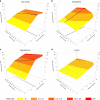Alcohol drinking and head and neck cancer risk: the joint effect of intensity and duration
- PMID: 32830199
- PMCID: PMC7592048
- DOI: 10.1038/s41416-020-01031-z
Alcohol drinking and head and neck cancer risk: the joint effect of intensity and duration
Abstract
Background: Alcohol is a well-established risk factor for head and neck cancer (HNC). This study aims to explore the effect of alcohol intensity and duration, as joint continuous exposures, on HNC risk.
Methods: Data from 26 case-control studies in the INHANCE Consortium were used, including never and current drinkers who drunk ≤10 drinks/day for ≤54 years (24234 controls, 4085 oral cavity, 3359 oropharyngeal, 983 hypopharyngeal and 3340 laryngeal cancers). The dose-response relationship between the risk and the joint exposure to drinking intensity and duration was investigated through bivariate regression spline models, adjusting for potential confounders, including tobacco smoking.
Results: For all subsites, cancer risk steeply increased with increasing drinks/day, with no appreciable threshold effect at lower intensities. For each intensity level, the risk of oral cavity, hypopharyngeal and laryngeal cancers did not vary according to years of drinking, suggesting no effect of duration. For oropharyngeal cancer, the risk increased with durations up to 28 years, flattening thereafter. The risk peaked at the higher levels of intensity and duration for all subsites (odds ratio = 7.95 for oral cavity, 12.86 for oropharynx, 24.96 for hypopharynx and 6.60 for larynx).
Conclusions: Present results further encourage the reduction of alcohol intensity to mitigate HNC risk.
Conflict of interest statement
The authors declare no competing interests.
Figures


References
-
- World Cancer Research Fund International/American Institute for Cancer Research. Diet, nutrition, physical activity, and cancer: A global perspective. Continuous Update Project Expert Report 2018. https://www.wcrf.org/dietandcancer. (2020).
-
- Praud D, Rota M, Rehm J, Shield K, Zatoński W, Hashibe M, et al. Cancer incidence and mortality attributable to alcohol consumption. Int. J. Cancer. 2016;138:1380–1387. - PubMed
-
- Di Maso M, Bravi F, Polesel J, Negri E, Decarli A, Serraino D, et al. Attributable fractions for multiple risk factors: Methods, interpretation and examples. Stat. Methods Med. Res. 2020;29:854–865. - PubMed
Publication types
MeSH terms
Grants and funding
- R01 DA012609/DA/NIDA NIH HHS/United States
- R01 DA011386/DA/NIDA NIH HHS/United States
- R01 DE013110/DE/NIDCR NIH HHS/United States
- R03 CA077954/CA/NCI NIH HHS/United States
- R01 CA100679/CA/NCI NIH HHS/United States
- R01 AG061188/AG/NIA NIH HHS/United States
- U01 CA096134/CA/NCI NIH HHS/United States
- R03 DE016611/DE/NIDCR NIH HHS/United States
- K07 CA104231/CA/NCI NIH HHS/United States
- R01 CA159036/CA/NCI NIH HHS/United States
- R01 CA078609/CA/NCI NIH HHS/United States
- P01 CA068384/CA/NCI NIH HHS/United States
- P30 ES010126/ES/NIEHS NIH HHS/United States
- R01 DA011979/DA/NIDA NIH HHS/United States
- R03 CA113157/CA/NCI NIH HHS/United States
- R01 CA048996/CA/NCI NIH HHS/United States
- R01 DE013158/DE/NIDCR NIH HHS/United States
- T32 CA009142/CA/NCI NIH HHS/United States
- R21 ES011667/ES/NIEHS NIH HHS/United States
- R01 CA031845/CA/NCI NIH HHS/United States
- P20 CA252728/CA/NCI NIH HHS/United States
- P50 CA090388/CA/NCI NIH HHS/United States
- R01 CA090731/CA/NCI NIH HHS/United States
- 001/WHO_/World Health Organization/International
- R01 CA030022/CA/NCI NIH HHS/United States
LinkOut - more resources
Full Text Sources
- Archivio Istituzionale della Ricerca Unimi - Access Free Full Text
- Enlighten: Publications, University of Glasgow - Access Free Full Text
- Europe PubMed Central
- Nature Publishing Group
- PubMed Central
- University of Turin Instituional Repository AperTO - Free full text
- eScholarship, University of California - Access Free Full Text
Medical

